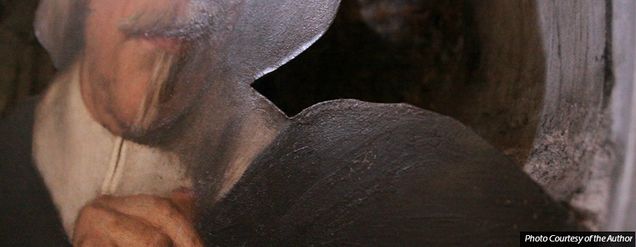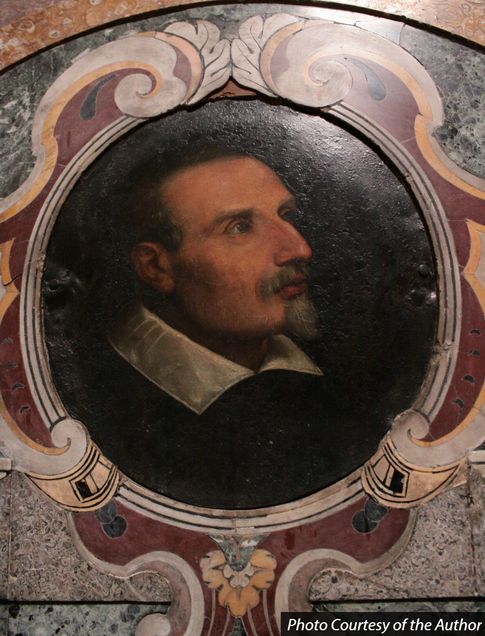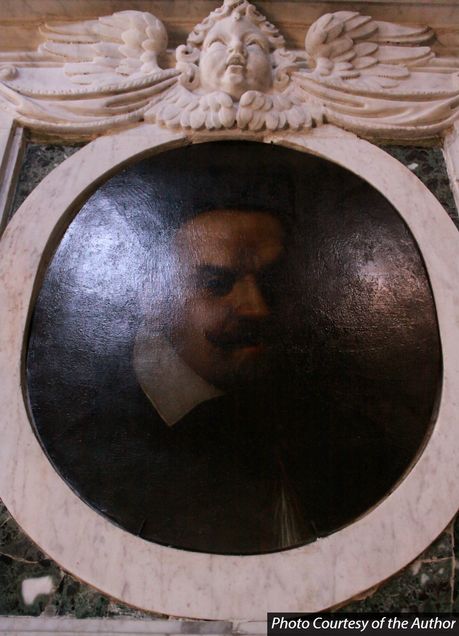Early Modern Funerary Portraits Painted on Metal and Stone Supports: Results of Field Work in Rome

In the spring of 2013, while conducting dissertation research in Rome, I noticed the funerary portraits of Gaspare Rivaldi and Ortenzia Mazziotti in the church of Santa Maria della Pace. Intrigued by their appearance, I inquired of the sacristan as to their material. (Fig. 1) To my surprise, he promptly tapped upon Signore Rivaldi’s visage as on the hood of a car, pointed to the over-painted rivets affixing the artwork to its marble frame, and said “aluminum.” [1] Although chemists did not produce pure aluminum until the nineteenth century, the sacristan correctly noted the support’s metallic composition. [2] Surprisingly, subsequent research revealed no investigations of these portraits or any others in situ in Rome painted in oils on metal plates or stone panels. [3] In fact, the Rivaldi/Mazziotti portraits of ca. 1611-1614 contradict expectations to find such artworks nowhere other than in early modern Wunderkammer collections as records of a Mannerist “evolution of taste and interest.” [4] But did these funerary effigies represent isolated instances or exemplars of a larger phenomenon overlooked by art historians?

I returned to Rome in the summer of 2014 in order to answer this question, and between June 14 and July 9 I examined the interiors of 137 churches, basilicas, and cloisters. [5] In 46 (34%), I found 108 funerary monuments that included two-dimensional effigies. [6] Of these, I discovered 21 (19%) on metal, 42 (39%) on stone, and another 24 (22%) in physically inaccessible positions but whose visual characteristics suggest stone or metal supports. [7] I photographed each monument and its portrait, and transcribed the accompanying Latin epigraph. These inscriptions indicate that patrons in Rome began installing commemorative portraits into their funerary monuments by the 1550s. The practice became especially popular during the first half of the seventeenth century, significantly diminished during the eighteenth century, and then reappeared during the third-quarter of the nineteenth century. [8] Such continuity over time is only matched by the ubiquitous distribution of oil-painted funerary effigies on metal and stone supports in all of Rome’s neighborhoods (rioni).
The identification of these artworks proved that the Rivaldi/Mazziotti portraits epitomize a type of aesthetic maintained over centuries in Rome and that entailed the installation of two-dimensional rather than three-dimensional effigies into mortuary monuments. [9] While the tradition encompassed portraits made on canvas, in buon fresco, or in the micro-mosaic technique, those painted in oils on round pieces of metal and stone exhibit comparatively excellent states of preservation. (Fig. 2)

Indeed, I hypothesize that early modern patrons began to utilize these supports due to the perception that they might endow simulacra with an enduring presence as durable as the materials themselves. Furthermore, by choosing a circular format, the early modern reader of Pliny the Elder’s Natural History knew that they emulated the Imago clipeata. [10] By having this classical Roman type painted, patrons re-conceptualized Pliny to accord with contemporary Christian theology and aesthetic theories about the efficacy of a polychromatic effigy to eternalize an individual’s body in anticipation of becoming entirely whole again upon reunification with the immortal soul at the Resurrection. [11]
Bradley J. Cavallo
____________________
Endnotes:
[1] Unless otherwise indicated, translations are the author’s.
[2] For the history of aluminum production, see Joseph William Richards, Aluminum. Its History, Occurrence, Properties, Metallurgy and Applications, Including Its Alloys (Philadelphia, PA: Henry Carey Baird & Co., 1890); Mimi Sheller, Aluminum Dreams: The Making of Light Modernity (Cambridge, MA: MIT Press, 2014).
[3] Even Ralph-Miklos Dobler’s 2009 study of the Rivaldi/Mazziotti chapel, which aids in the attribution of these portraits to the Bolognese painter Lavinia Fontana (d. 1614), ignores the painted funerary portraits. See Die Juristenkapellen Rivaldi, Cerri und Antamoro: Form, Funktion und Intention römischer Familienkapellen im Sei- und Settecento (Munich: Hirmer verlag, 2009).
[4] Anne Laure Collomb, “Les traités artistiques et la peinture sur pierre (XVIe-XVIIe siècles),” Histoire de L’Art, no. 52 (June, 2003): 117.
[5] Seven other edifices were closed at the time due to restorations.
[6] The 1682 monument to Valentino Onorato is the only known example positioned on the exterior of a building. Because it stands on a pier in the portico of Santa Maria in Trastevere, Valentino’s painted effigy exhibits the blue-green, Copper (II) acetate stain of Verdigris on the lower lip of the surrounding marble frame as a result of the physically-degrading, corrosive reaction of the copper support to weathering and pollutants.
[7] Of the 19 (18%) other two-dimensional, funerary effigies that I documented, 9 (8%) are made in the micro-mosaic technique, 4 (4%) are in buon fresco, and 6 (6%) are in oils on canvas. Another 26 (19%) monuments contain blank, oval spaces where a two-dimensional portrait was, could, or may have been installed originally and then removed.
[8] All but the Rivaldi/Mazziotti portraits are by unidentified artists.
[9] Even Gian Lorenzo Bernini noted the benefits of a painted portrait vis-à-vis marble. In 1638, he is recorded as having stated (with reference to the Pope), “I told his Holiness that if he went into the next rome and whyted all his face over…and came fort againe nott being a whit leaner nor lesse beard, only chaunging his coulour, no man would know you…[for] How can itt…be possible that a marble picture can ressemble…nature when itt is all one coulour…?” Quoted in Andrea Bacchi and Catherine Hess, “Creating a New Likeness. Bernini’s Transformation of the Portrait Bust,” in Bernini and the Birth of Baroque Portrait Sculpture, ed. Andrea Bacchi et al. (Los Angeles, CA: Getty Publications, 2008), 1.
[10] For Pliny the Elder’s description of the Roman Imago clipeata, see Natural History in Ten Volumes, trans. H. Rackham, M.A., volume IX, Libri xxxiii-xxxv (Cambridge, MA: Harvard University Press, 1969), xxxv. I. 3-11. 5, 262-271. For scholarly examinations of the imago clipeata, see Cornelius C. Vermeule, III, who notes many Roman sarcophagi inclusive of the imago clipeata known by the early modern period. See his “A Greek Theme and Its Survivals: The Ruler’s Shield (Tondo Image) in Tomb and Temple,” Proceedings of the American Philosophical Society 109, no. 6 (Dec., 1965): 361-397. For other detailed studies of the Imago clipeata, see Rolf Winkes, “Pliny’s Chapter on Roman Funeral Customs in the Light of Clipeatae Imagines,” American Journal of Archaeology 83, no. 4 (Oct., 1979): 481-484; Andrá Grabar, “L’imago clipeata chrétienne,” in Comptes rendus des séances de l’Academie des Inscriptions et Belles-Lettres 101, no. 2 (1957): 209-213; Donatella Scarpellini, Stele romane con imagines clipeatae in Italia (Rome: ‘L’Erma’ di Bretschneider, 1987); Rudolf Winkes, Clipeata imago. Studien zu einer römischen Bildnisform (Bonn: R. Habelt, 1969).
[11] For discussions of the immortality of the soul during the early modern period, see The Catechism of The Council of Trent, Published by Command of Pope Pius the Fifth, trans. Rev. J. Donovan (Dublin: Richard Coyne, 1829), 115-126; Paul Oskar Kristeller, “The Immortality of the Soul,” in Renaissance Thought and Its Sources, ed. Michael Mooney (New York, NY: Columbia University Press, 1979), 181-196; Eric A. Constant, “A Reinterpretation of the Fifth Lateran Council Decree Apostolici regiminis (1513),” The Sixteenth Century Journal 33, no. 2 (Summer, 2002): 353-379; Lorenzo Casini, “The Renaissance Debate On the Immortality of the Soul. Pietro Pomponazzi and the Plurality of Substantial Forms,” in Mind, Cognition and Representation: The Tradition of Commentaries on Aristotle’s De Anima, ed. Paul J.J.M. Bakker and Johannes M.M.H Thijssen (Burlington, VT: Ashgate Publishing Company, 2007), 127-150.